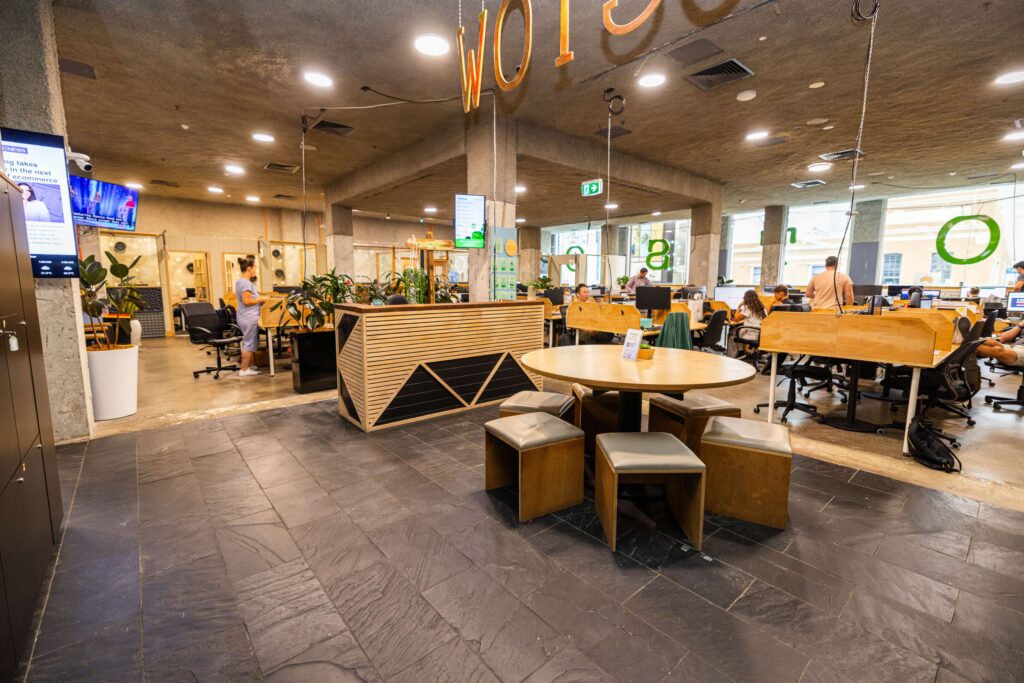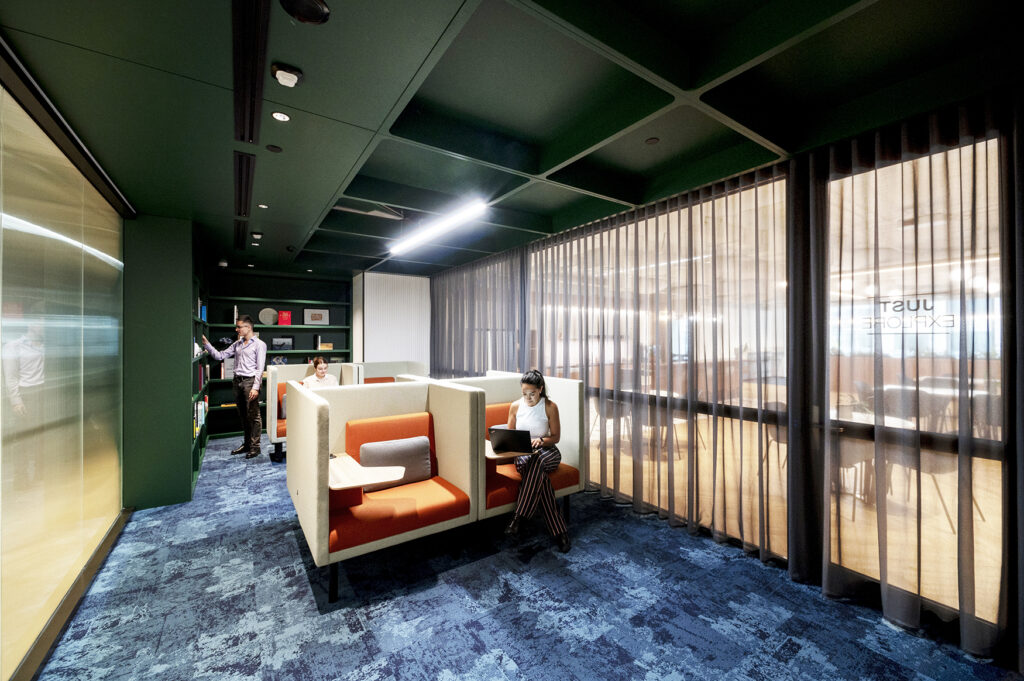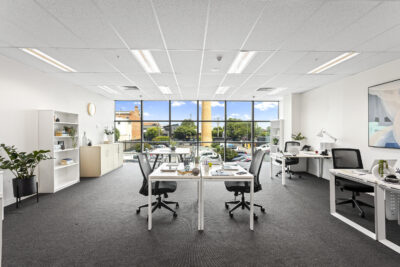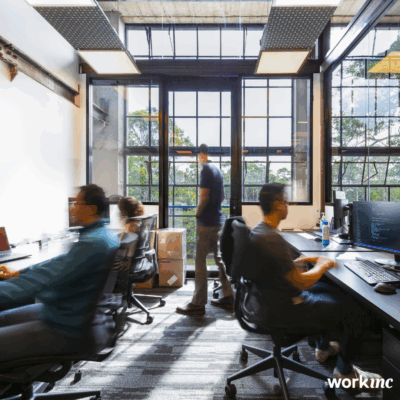
Image source: https://flexfind.com.au/listing/9-13-bronte-road-bondi-junction/
Flexible office space has become the cornerstone of modern business, transforming how organisations utilise workspace and empowering employees to work more effectively. Unlike traditional office spaces, flexible workspaces provide employees with dynamic environments that cater to evolving needs. This adaptability, coupled with cutting-edge technology and ergonomic furniture, ensures that businesses stay ahead in an ever-changing world.
This article explores the benefits, features, and applications of flexible offices while comparing them to traditional office setups. From coworking spaces to private offices and shared facilities, discover why flexible workspace solutions are redefining the professional environment.
What Is Flexible Office Space?
Flexible workspace refers to a workspace designed to adapt to the diverse needs of employees and businesses. These workspaces combine open-plan designs, private offices, and shared spaces, offering a mix of collaboration zones, quiet areas, and adaptable workstations. They are the most flexible workspaces available, making them ideal for businesses that prioritise productivity, work-life balance, and cost efficiency.
One of the key characteristics of flexible spaces is their focus on versatility. Whether you’re part of a startup, a growing business, or a large corporation, flexible workspace solutions offer short-term leases and flexible memberships to match your needs. With shared facilities like meeting rooms, coffee bars, and event spaces, these offices support collaboration while maintaining a professional environment.
The Rise of Flexible Workspaces in the Modern Workplace
The transition from traditional offices to flexible office solutions is driven by several factors, including changing office cultures and advancements in workspace design. Unlike traditional offices, where assigned desks and fixed locations dominate, flex office spaces offer the freedom to choose where and how you work. CBRE has completed a $400million (US) takeover of Industrius, this shows how commercial office space is now trending towards more flexible spaces.
Businesses today recognise the importance of providing employees with environments that enhance productivity and creativity. Interior designers play a vital role in creating open-plan offices with natural light, communal areas, and quiet zones, ensuring a perfect space for every need. Flexible workspaces also cater to hybrid and remote work models by allowing employees to work in-office or remotely with minimal disruption.
Key Characteristics of Flexible Workspaces
Flexible workspaces are defined by features that accommodate various work styles and objectives. Open-plan layouts foster collaboration by eliminating physical barriers, allowing larger teams to communicate seamlessly. Quiet areas, often referred to as focus zones, provide employees with spaces to concentrate on tasks that require increased focus.
Shared office facilities, such as high-speed internet and on-demand access to meeting rooms, ensure that businesses can operate efficiently. Adaptable workstations, including standing desks and modular furniture, are fundamental aspects of these spaces, promoting comfort and flexibility. Coffee bars and shared communal areas add a touch of casual professionalism, making workspaces more inviting and functional.
Benefits of Flexible Office Space Over Traditional Offices
Flexible office spaces offer a range of advantages that make them a preferred choice for modern businesses. They provide adaptability, efficiency, and cost-effectiveness that traditional office spaces struggle to deliver. Here’s a closer look at these benefits, supported by data and insights:
Adaptability to Evolving Needs

Image source: https://flexfind.com.au/listing/447-collins-street-melbourne/
One of the primary advantages of flexible workspace is their ability to adapt to changing business needs. Traditional offices often feature fixed desk layouts and long-term leases, which can limit a company’s ability to grow or downsize quickly. In contrast, flexible spaces are designed with scalability in mind, enabling businesses to adjust their office footprint with minimal disruption.
Flexibility is increasingly sought after by the workforce. A study by LiveCareer found that, on average, 70% of employees across generations value flexibility in their work arrangements. When it comes to the most important benefits, flexible working options were a top priority for 34% of Millennials, 33% of Gen X, and 32% of Gen Z. This highlights the growing preference for adaptable work environments across all age groups.
Maximising Space Utilisation
Flexible spaces enable businesses to make the most of their office real estate. Traditional offices often suffer from underused areas, such as vacant meeting rooms or empty desks. Flexible office environments, on the other hand, optimise space usage through shared workspaces, leading to significant cost savings.
The rise of flexible spaces is gaining traction across global markets. In fact, flexible working space, which once represented just 1% of office stock in many markets, is now rapidly increasing. In Europe, particularly in cities like Amsterdam, flexible spaces accounted for over 5% of office stock, signalling a strong shift in how companies view office layouts and leasing.
The demand for flexible spaces is projected to continue growing. JLL forecasts that Europe’s flexible office space market will expand by as much as 30% annually, further reinforcing the cost-effectiveness and adaptability that such spaces offer. Short-term leases, a key feature of flexible workspaces, contribute to this adaptability, allowing businesses to experiment with locations and office configurations without long-term commitments.
Enhanced Employee Satisfaction and Productivity
Flexible office spaces are not just about cost savings; they also foster an environment that promotes productivity and job satisfaction. Traditional offices often prioritise functionality over employee comfort, with rigid desk layouts and limited amenities. Flexible workspaces, in contrast, cater to diverse work styles by offering varied spaces for collaboration, focused work, and individual tasks.
Open-plan layouts encourage teamwork, while quiet zones and private offices provide areas for concentrated work. Amenities such as ergonomic furniture, natural light, and communal coffee bars contribute to a more inviting atmosphere, which can enhance employee well-being and satisfaction.
The Gensler Global Workplace Survey underscores the importance of such work environments. It reveals that employees in well-designed offices—those that offer flexibility and support for different work modes—report a 94% positive impact on productivity. In contrast, those in offices that fail to meet these needs show far less improvement, emphasising that workspaces that align with employees’ expectations and needs are key to boosting both satisfaction and productivity.
Improved Agility for Business Transitions
Flexible office spaces are invaluable during periods of transition, such as business growth, mergers, or shifting market conditions. With flexible terms and on-demand access to workspace solutions, companies can quickly adapt to new challenges. For instance, during the COVID-19 pandemic, businesses that utilised flexible workspaces were able to downsize their physical office space while maintaining operational continuity.
The ability to create a professional environment tailored to specific projects or teams is another benefit. Businesses can set up project-specific spaces for collaboration or rent meeting rooms equipped with cutting-edge technology for client presentations. This agility is difficult to achieve in traditional office setups, where fixed locations and limited configurations dominate.
Flexible Workspaces and Their Impact on Office Culture
Office culture is a critical factor in employee satisfaction and productivity. Flexible workspace solutions foster a positive work environment by allowing employees to choose how they work. Networking opportunities are naturally embedded into the design of shared spaces, encouraging strong relationships among colleagues.
Moreover, flexible terms allow businesses to prioritise employee well-being. By providing employees with ergonomic furniture, focus zones, and access to natural light, organisations can support their teams’ physical and mental health. This holistic approach to workspace design leads to increased focus, collaboration, and morale.
Why Businesses Are Embracing Shared Workspaces
Shared workspaces have gained popularity for their ability to accommodate diverse work styles. They combine the benefits of coworking spaces with the privacy of traditional offices, creating environments where individuals and teams can thrive. For example, businesses can utilise shared spaces for collaborative projects while reserving private offices for sensitive discussions or individual tasks.
These spaces also offer flexible memberships, enabling businesses to adjust their office requirements based on current needs. With features like shared facilities and communal areas, shared workspaces provide a balance between collaboration and individual focus, making them a versatile choice for modern organisations.
The Role of Technology in Flexible Workspaces
Cutting-edge technology is a cornerstone of flexible office solutions, ensuring seamless communication and productivity. High-speed internet and robust network systems enable employees to work efficiently, whether in meeting rooms or shared office areas. Additionally, standardised AV setups across locations make it easy to host presentations and video conferences, supporting hybrid work models.
Technology also plays a role in creating on-demand access to workspace solutions. Many flexible office providers offer digital platforms that allow employees to book desks, meeting rooms, or event spaces in real-time, ensuring maximum convenience and efficiency.
Flexible Office Spaces in Australia: A Case Study
Australia has seen a surge in the adoption of flexible office spaces, particularly in cities like Sydney, Melbourne, Adelaide, Perth and Brisbane. The flexible workspace industry in Australia caters to businesses of all sizes, offering workspace solutions that prioritise adaptability and employee satisfaction.
These spaces often feature open-plan designs, private offices, and shared facilities, creating the perfect space for collaboration and focus. With short-term leases and flexible terms, Australian businesses can easily scale their office requirements based on demand, making it a strategic choice for growing companies.
Challenges Solved by Flexible Office Spaces
Traditional offices often struggle to accommodate the dynamic nature of modern work. Fixed desk layouts, limited meeting rooms, and rigid office footprints can hinder productivity and creativity. Flexible spaces address these challenges by offering adaptable solutions that cater to different work styles.
For example, businesses can reduce costs by opting for shared office facilities instead of maintaining unused desks. Meeting pods and quiet zones provide employees with the freedom to choose their ideal workspace, ensuring minimal disruption to their workflow. These flexible office solutions create a more agile and responsive work environment, helping businesses overcome common workplace challenges.
Conclusion: The Future of Work Is Flexible
Flexible office spaces represent a paradigm shift in how businesses think about work environments. By combining adaptability, efficiency, and employee-centric design, these workspaces provide the ideal solution for modern organisations. From coworking spaces to shared facilities, flexible workspace solutions cater to the evolving needs of businesses and employees alike.
As businesses continue to embrace innovation, flexible office spaces will remain at the forefront of workspace design. By adopting these solutions, companies can stay ahead, fostering creativity, collaboration, and sustainability while creating the perfect space for success.



